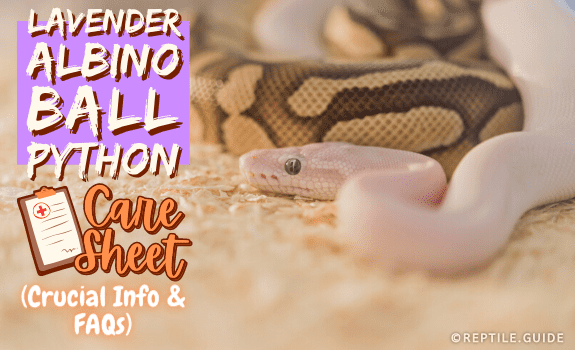The lavender albino ball python, also known simply as the lavender ball python, is a popular morph.
This morph requires much the same care as other ball pythons, reaches similar sizes, and behaves like other morphs.
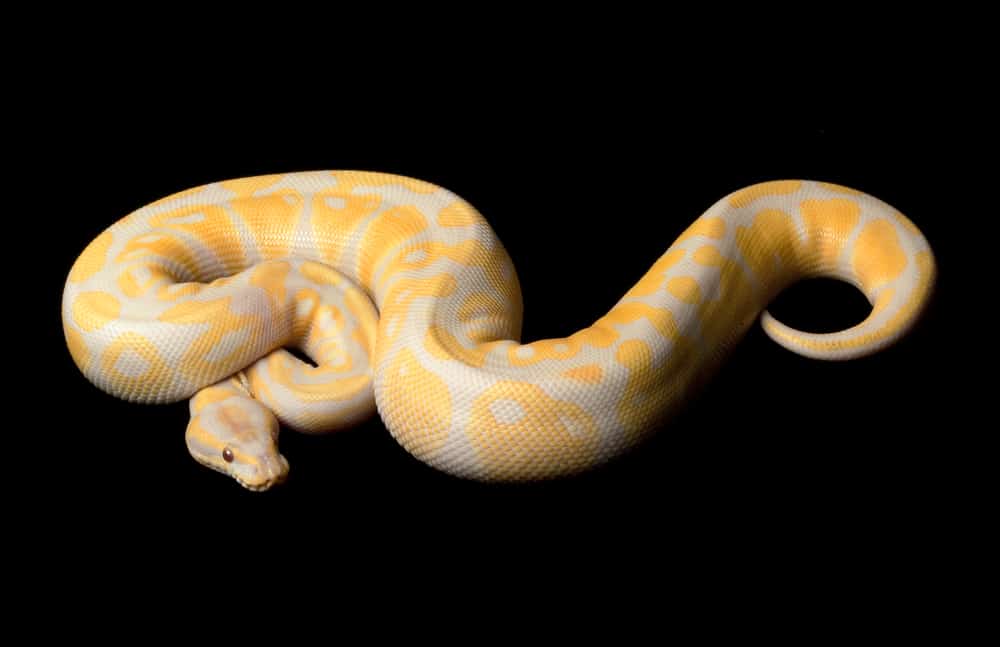
Below, we’ll take a closer look at the
- Lavender ball python size
- Lavender ball python morphs
- Lavender Albino ball python price
- Where to buy a lavender albino ball python
In This Article
What Are Lavender Albino Ball Python Morphs?
Lavender albinos are one morph or color form of the ball python, Python regius.
They look similar to normal albinos. However, instead of the white base color, they have a lovely lavender base.
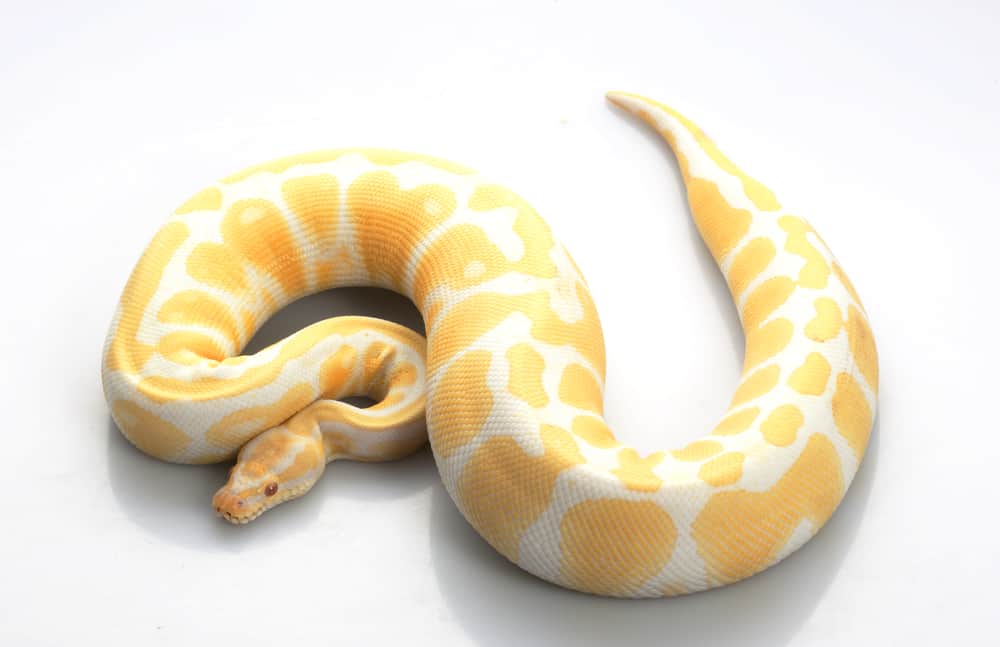
The patterns on a lavender albino ball python tend to be brighter. They’re more of a rich golden color than a pale yellow.
Lavender albino ball pythons are the result of a recessive gene.
Since the lavender gene is recessive, breeders can breed the gene into nearly any morph.
As long as both parents have this recessive gene, a percentage of the offspring will be lavender albino ball pythons.
Through carefully regulated breeding practices, breeders create new morphs with the subtle high-contrast beauty of the lavender albino.
Lavender Albino Ball Python Appearance
A Lavender albino ball python looks similar to any other albino ball python. The main difference lies in the coloration.
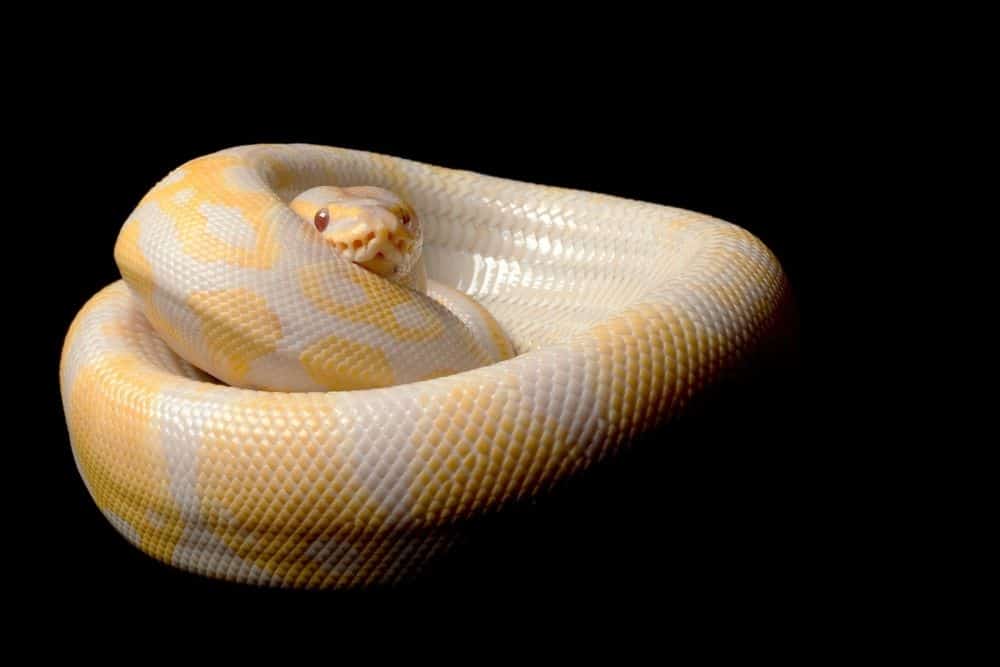
A standard albino ball has a white background with peachy-yellow patterns.
The lavender albino ball python has a lavender background with richer golden hues in the patterning.
This morph retains the large head that’s common to ball pythons, as well as the bulky build.
Albino Ball Python Price
Lavender albino morphs can cost anything from $300 to $6,000.
A standard lavender albino snake with the lavender base color and no distinguishing features would probably cost less in comparison to more decorated individuals.
Snakes that have other rare morphs in their ancestry cost more. For example, a lavender piebald can easily cost over $1,500.
The type of morph you buy determines the snake’s price.
Where to Buy Lavender Albino Ball Pythons
The following sections will review some places to buy your new lavender albino ball python.
You’ll notice that all our recommendations have one thing in common: you get to talk to the breeder and learn from them.
Many different places sell ball pythons, but not all of them are equally trustworthy.
Some places we don’t recommend buying lavender albino ball pythons from include pet stores and general listing websites.
Pet stores often have little more than a cursory knowledge of how to care for the snakes. They probably also won’t have background information about their animals.
It’s not unusual to see ball pythons on general advertising websites. However, you have no guarantee that the seller is a trustworthy breeder.
We recommend buying from a trusted breeder through one of the platforms mentioned below.
Directly From the Breeder
Many trusted breeders have websites, and you can order directly from them.
Always check with other enthusiasts or review sites to find out the credibility of the breeder from past customers.
Online Reptile Marketplaces
Online reptile marketplaces like MorphMarket are some of the best places to buy ball python morphs.
Sites like this one review every breeder to ensure that only the best animals are for sale on the site. They also offer legal protection for buyers.
If you order through an online marketplace, the breeder will courier the animal to you. It should arrive within 48 hours.
Reptile Conventions and Expos
If you go to your nearest Repticon or reptile expo, you’re bound to find a breeder with lavender albino ball pythons.
As with an online marketplace, the organizers check each breeder’s references and animals to ensure that they’re offering a quality service.
How Big Do Lavender Albino Ball Pythons Get?
A full-grown albino ball python reaches lengths of up to 6 feet.
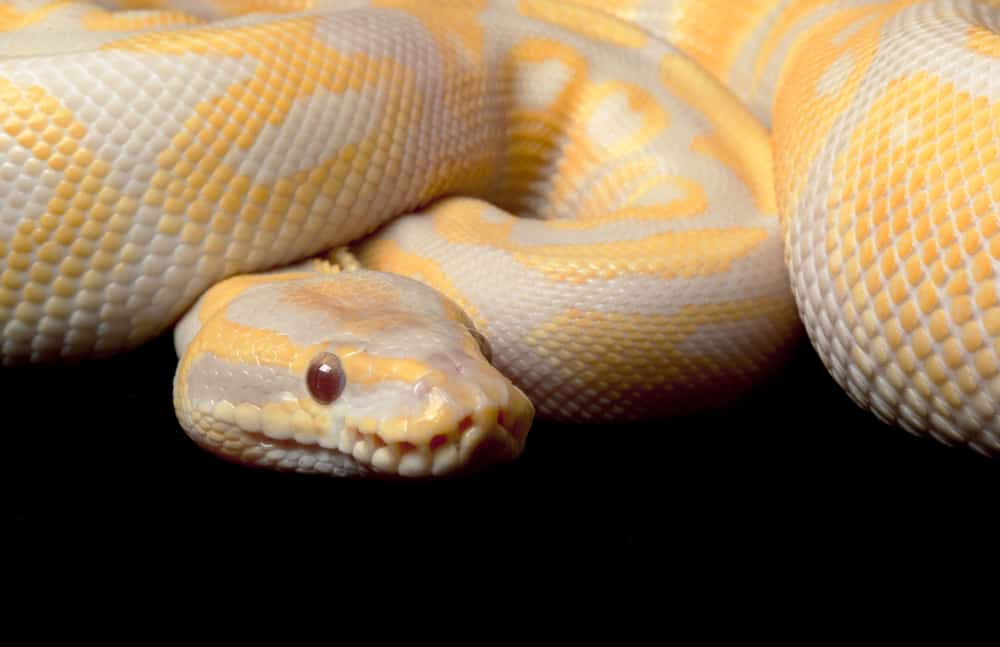
There’s no real difference between ball python morphs other than their coloration.
In length, care, and behavior, the lavender albino ball python is just like other morphs.
Female ball pythons of any morph are generally longer than males. There can be a length difference of up to two feet between the sexes.
The average ball python size for any morph is around five feet.
Caring For Lavender Albinos
All ball python, Python regius, morphs require the same basic care.
The following sections will cover the basic requirements of these animals.
Enclosure Size
Ball pythons usually need three cages in their lives.
- You can easily keep hatchlings and juveniles in 10-gallon enclosures.
- Older animals will live comfortably in 20-gallon enclosures.
- Full-grown snakes need 30-40 gallon enclosures.
Check out our ball python enclosure guide for the full scoop on how to house your snake, and when to upgrade it’s enclosure.
Substrate
Choosing the right substrate for your snake helps maintain humidity levels and facilitate cleaning.
Some of our favorite ball python substrates include:
Each substrate has advantages and disadvantages, but in the end, it comes down to what works for you and your pet snake.
If you live in a low-humidity area, consider something like orchid bark or cypress mulch which maintains moisture well.
All of the abovementioned substrates are easy to use and clean and maintain humidity well.
Substrates that you should never use for your snakes include:
- Sand
- Gravel
- Artificial outdoor carpet
- Pine and paper shavings
All these products can cause impaction, or damage your snake’s body.
Heating and Humidity
Ball pythons don’t have many requirements for heating and lighting.
As with most reptiles in captivity, these animals need a temperature gradient to stay healthy.
Reptiles can’t control their body temperatures internally so they need heat zones in their enclosure.
You accomplish this by heating only one part of the tank. We recommend using a basking light or ceramic heat emitter to heat one-half of the enclosure.
It’s a good idea to have a thermometer/hygrometer combo on each side of the cage. They will help you monitor conditions throughout the enclosure.
You should aim at providing the following temperatures:
- Cool end – 76-80°F
- Basking spot – 88-92°F
- Ambient temperature – 81-83°F
- Night-time temperature – No higher than 75°F
Despite coming from a tropical climate, these snakes don’t have the high humidity requirements of some tropical species.
Ball pythons need a relative humidity of 50-60%. You can accomplish this easily by misting regularly and using a large flat water bowl.
Lighting
Ball pythons don’t need much lighting. As long as you provide them with a day and night light cycle, they’ll do just fine.
Aim for 12 hours with light every day, and 12 hours without. You can use full-spectrum LED lighting, or choose to use UVA or UVB bulbs.
While these animals don’t need UVB to survive, it can help boost their coloration and immunity.
If you’re using a heat lamp to heat the enclosure, you don’t need additional lighting.
However, you’ll need a heating pad or ceramic heat emitter to maintain the temperature at night.
You can also choose to use a timer to automatically switch the lights on and off every day.
Security and Setup
Ball pythons don’t need a lot to feel safe and secure.
Once you’ve added a safe substrate, like cypress mulch, you need only a few more things, namely:
- Hides
- Objects to climb on
- Water and food bowls
We suggest using three hides:
- A humid hide
- One on the cool side of the enclosure
- One on the warm side of the enclosure
This setup will allow the snake to rest in the temperature zone that suits it best. A humid hide is simply a hide filled with moist substrate.
It has a higher humidity level than the surrounding enclosure, providing the snakes with an ideal place to shed or fight infections.
The water and food bowls have obvious uses. However, the water bowl also helps to manage humidity levels in the enclosure.
These snakes love to explore from time to time, so they’ll also appreciate the addition of branches or other objects they can climb on.
Diet
In the wild, a ball python diet consists of anything the snake can catch.
This snake typically lives near water where it feeds on amphibians, birds, reptiles, and small rodents.
In captivity, you can feed your pet:
- Rats
- Mice
- Chicks
There’s a variety of small feeders on the market, all of which work well for these reptiles.
Young ball pythons, under a year old, need to eat once a week. Older animals need a meal every 10 to 14 days.
Rule of Thumb: Never feed your python a meal that’s bigger than the widest part of the snake.
If you’re looking for a reliable ball python food and supplies online store, we recommend Chewy! It is the most trusted and convenient online destination for reptile pet owners.
Click here to save 30% on your first order. We may receive a small commission if you purchase after clicking.
This DOESN’T change what you pay or what we recommend. It does help fund the research we put into the site, and we’re grateful for any support!
Lavender Ball Python Morphs
Lavender albino ball pythons have been instrumental in the creation of several other morphs.
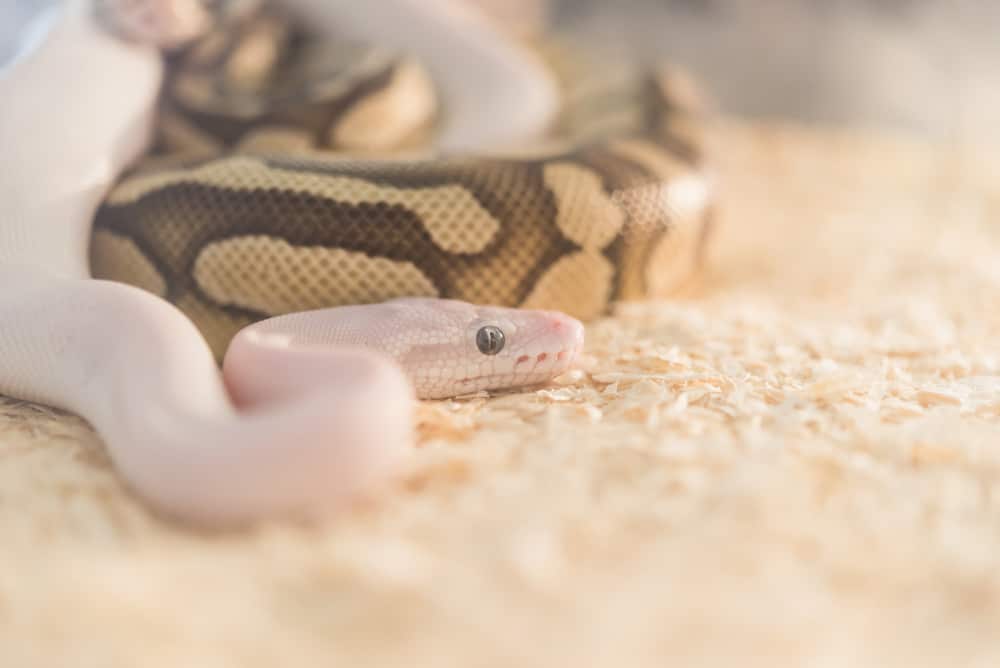
The list includes morphs such as the:
- Leopard lavender ball python
- Lavender albino pied ball python
- Lavender albino spider ball python
We’ve also seen people searching for odd morphs that don’t exist, like lilac lavender albino ball python and purple lavender albino ball python morphs.
Keep your eye out, though!
New ball pythons arrive on the scene every day, and it might be just a matter of time before you see purple lavender (purple purple?) ball pythons.
Lavender Albino Pied Ball Python
This spectacular morph is a cross between the lavender albino ball python and the pied ball python.
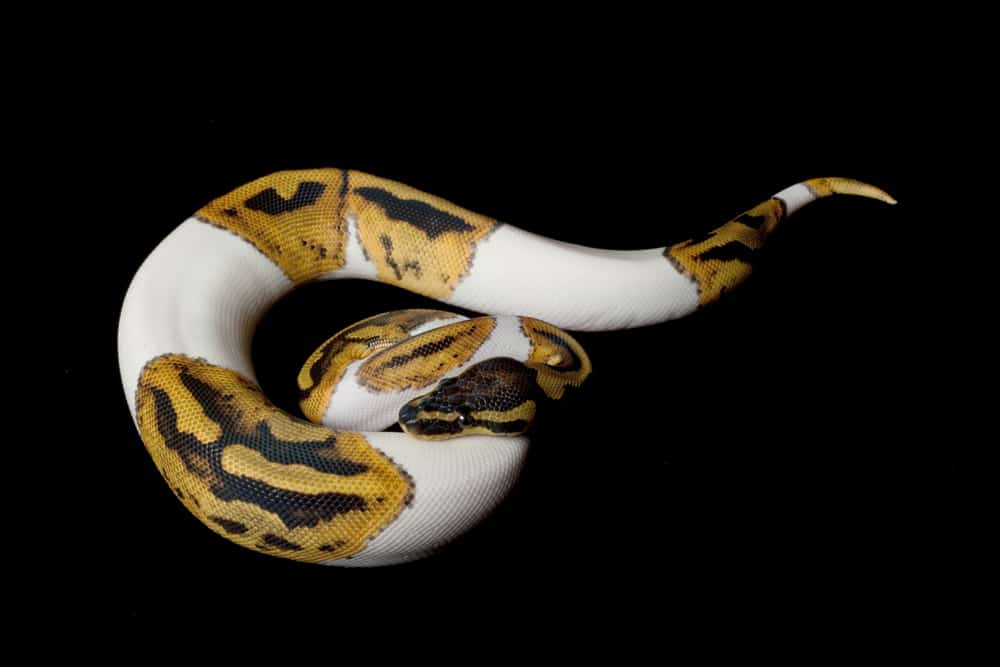
The genes for lavender albino ball pythons and piebalds are both recessive.
To get a lavender albino pied, both parents need to carry the gene for lavender albino, and the gene for piebald.
As you can imagine, this means that the breeding process for the lavender pied takes several generations.
Leopard Lavender Ball Python
The leopard lavender albino is a cross between leopard and lavender ball pythons.
They have leopard-like patterns and the coloration of lavender albinos. The leopard gene is dominant, so these animals are easier to produce than lavender pied ball pythons.
Lavender Albino Spider Ball Python
These animals have the bright, but pale, coloration of lavender albino ball pythons, and the unique patterns of spider ball pythons.
While these animals are beautiful, many breeders question whether it’s ethical to breed them.
Most ball pythons with the spider gene tend to suffer from kinking or wobbling.
These are painful genetic conditions that lead to a kinked spine or a head that wobbles from side to side.
Only you know where you stand on this subject. From our side, we don’t recommend buying animals with the spider gene in their ancestry.
We hope you’ve enjoyed this article about lavender albino ball pythons. If you’d like to learn more about these amazing creatures, check out our 39 ball python facts.
What do you like most about lavender albinos? Let us know in the comments.
